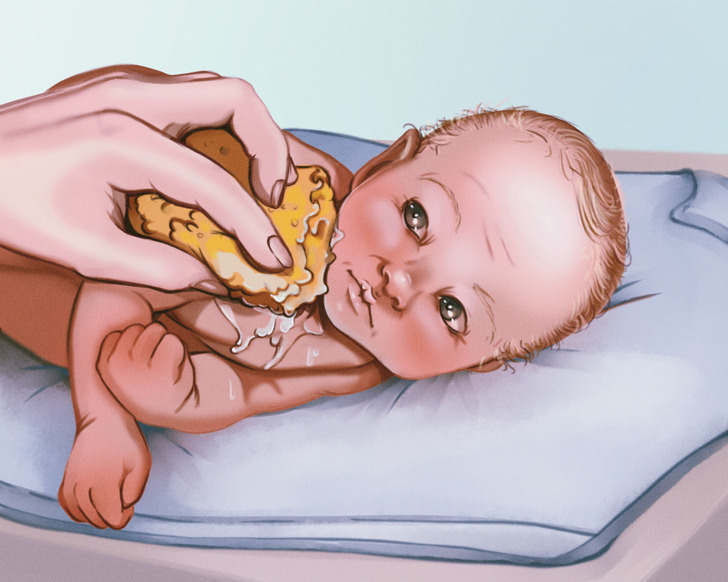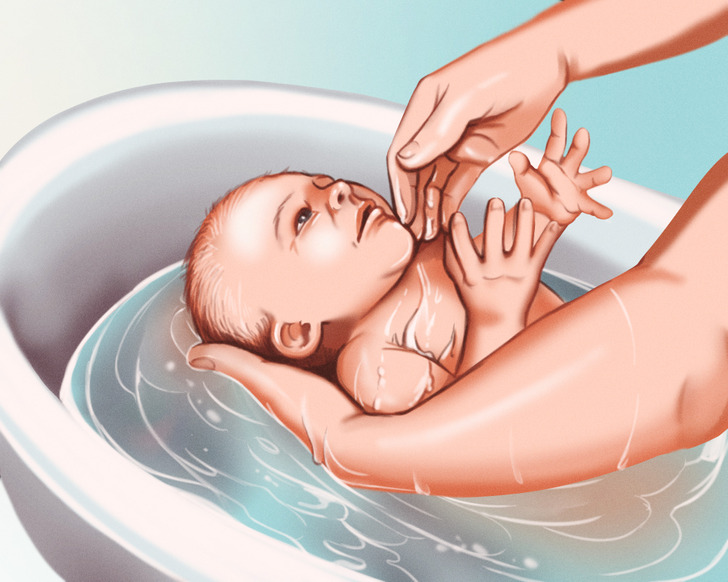5+ Things You Should Know Before Bathing a Newborn
New parents are often confused about how to care for their newborns’ hygienic needs. We’ve prepared a guide based on experts’ recommendations and will answer all your questions about bathing a newborn.
❗ This article is for information only and can’t replace an expert’s recommendations.
When a baby should be bathed for the first time
Until recently, it was believed that babies should be bathed during the first hours after birth. But over time, the opinion of doctors has changed. WHO recommends delaying your baby’s first bath until 24 hours after birth, or waiting at least 6 hours if you don’t want to delay it for some reason. This will allow the baby to more easily adjust to life outside the womb.
A baby is born covered in a waxy coating called vernix. This coating is a natural moisturizer and has antibacterial properties. By delaying the first bath, you can help your baby’s skin stay soft and clear longer. Also, this can help avoid a drop in the baby’s body temperature and a decrease in blood sugar levels.
How often you should bathe a baby
You’ve probably heard that newborns need to be bathed daily. However, experts say that this isn’t the case. If you take care of your baby’s hygiene during the day (wipe and wash the diaper area thoroughly, wash their hands and face), you can bathe the baby 2-4 times a week during the first months of their life. Babies rarely sweat and hardly get dirty, so they don’t need daily baths. Too frequent baths, on the other hand, can dry out your baby’s sensitive skin.
To keep your baby’s skin clean between baths, check folds on your baby’s body regularly: examine the thighs, armpits, groin, and chin, and wipe these areas with a damp cloth if necessary.
How to bathe a baby if their umbilical cord stump hasn’t fallen off

Pediatricians recommend replacing bathing with wiping the baby with a damp sponge until the umbilical cord stump falls off. On average, this takes 1 to 2 weeks.
A sponge bath is very similar to a regular bath. You don’t need to put your baby into the water. To bathe a baby, follow these simple steps:
- Choose a warm, draft-free room. Find a flat, fairly firm surface (a changing table, nightstand, or firm bed will do) and cover it with a soft blanket or towel.
- Pour warm water into a basin. Check the temperature with your hand or a water thermometer to make sure it’s not too hot.
- Prepare a washcloth, towel, fragrance-free baby soap, a clean diaper, and a change of clothes.
- Undress the baby and wrap them in the towel, and then lay them on their back in the prepared place.
- Wet a washcloth with warm water, wring out any excess water, and gently wipe the baby’s face.
- By moving down, alternately expose the baby’s body parts and wipe them with a sponge. Pay special attention to the creases under the arms, behind the ears, around the neck, and in the diaper area. Wash your baby’s fingers and toes.
- For some parts of the body, you can use a little soap. But don’t forget to rinse them with water well afterward.
- After you finish bathing them, dry your baby well and put on a fresh diaper and clean clothes.
❗ Don’t forget to constantly hold the baby during the procedure and don’t leave them unattended.
How to bathe a baby after the umbilical cord stump falls off

Once the umbilical area is healed, you can bathe your baby in water. At first, they may not like water procedures, so try to make baths as short and comfortable as possible for them. Don’t bathe your baby right after a feed or when they’re hungry or tired.
When you’re ready, follow these steps:
- Prepare everything you need: a baby bath, 2 towels, a clean diaper, clothes, and cotton wool.
- Pour a bit of water into the bath, stir it, and check the temperature. Please note that the water should be warm, not hot.
- Don’t add any liquid cleansers to the bath and bathe your baby only with plain warm water during the first month.
- Before putting the baby into the water, lay them on your lap and clean their face with cotton wool.
- While holding the baby over the bath, lightly massage and rinse their head, then dry it with a towel.
- After the baby’s upper body has been washed, remove the diaper and wipe the dirt with a damp cloth.
- After completing all the previous steps, put the baby into the bath. Be sure to hold their head and shoulders so that their upper body isn’t touched by the water.
- With your free hand, gently pour water over your baby’s body, gently massaging the skin.
- Carefully lift the baby out of the bath, dry them with a towel, and then put on a diaper and clean clothes.
❗ Never leave your baby unattended in the bath. If you need to go somewhere, be sure to take them with you.
Frequent questions and answers
- What if the baby cries every time you try to give them a bath?
The baby may be hungry or afraid to be alone in the water. Also, the baby may find the temperature of the water too hot or too cold. - Do you need to use a moisturizer every time after bathing?
Pediatricians say that oils and powders are not required after bathing since the baby’s skin is naturally well hydrated. Some skincare products can even do more harm than good. For example, they can accumulate in the folds, causing irritation and rashes. - Should you wash the newborn’s hair with soap?
You can simply wash the baby’s hair with water or use a mild baby cleanser. If you are using shampoo, massage a drop of it into your baby’s scalp. Then remove the foam by gently pouring water over the baby’s head. Be careful to keep foam and shampoo out of your baby’s eyes. - How much water should you be putting in the bath for bathing?
Not much — pediatricians recommend putting about 2 inches of water into the bath. - What should the water temperature be?
Warm water is best for bathing. Some babies like cooler water, while others like it hotter, but on average, experts recommend aiming for bath water around 100°F.